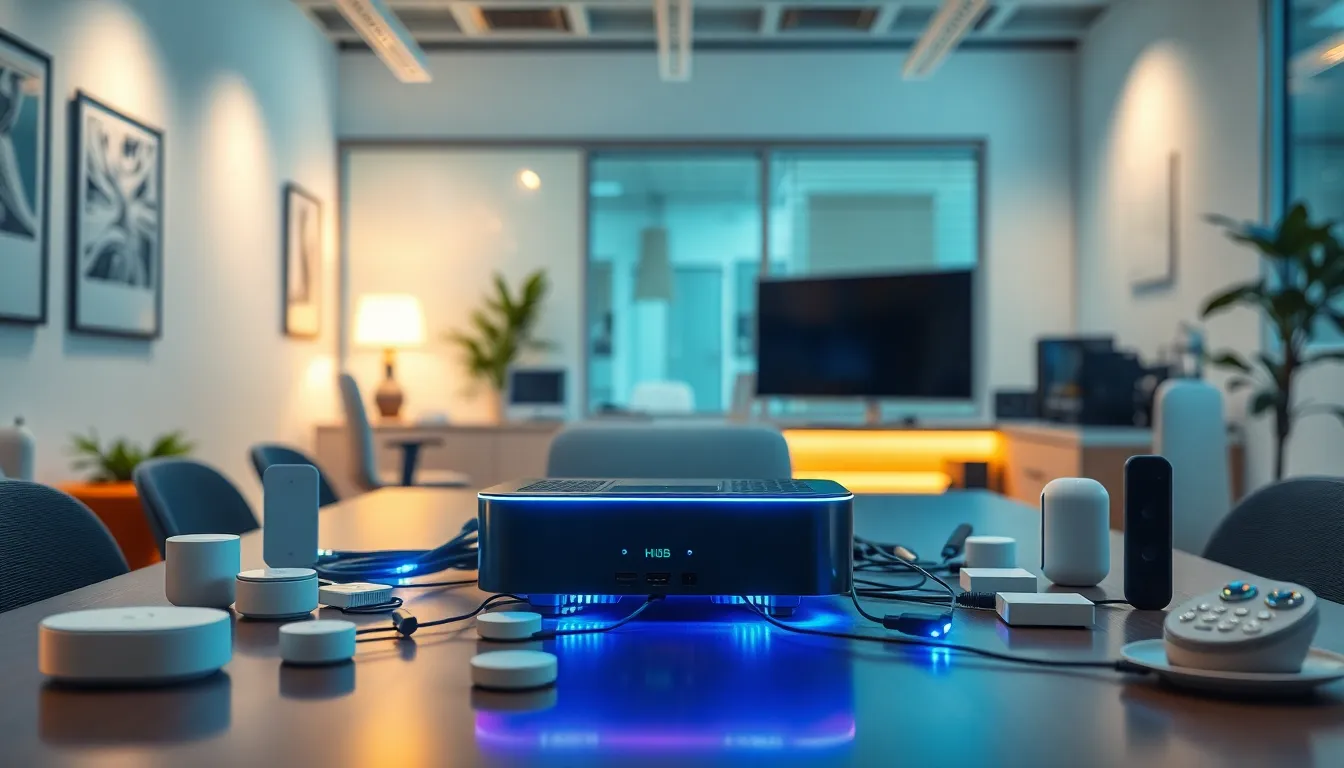Table of Contents
ToggleIn a world where your toaster might be smarter than your high school math teacher, the Internet of Things (IoT) hub stands as the command center of this quirky digital universe. Imagine a place where all your devices chat, collaborate, and sometimes bicker over who gets to control the coffee maker. It’s not just tech wizardry; it’s the future of connectivity.
Overview of IoT Hubs
IoT hubs act as essential connectors in the Internet of Things ecosystem, facilitating communication between devices. These hubs enable seamless data exchange and centralized management of various connected devices.
Definition of IoT Hub
An IoT hub serves as a centralized platform designed to manage device communications. It allows devices to connect, communicate, and transfer data securely. Hubs can handle multiple protocols and standards, ensuring compatibility among diverse devices. For example, a hub can connect smart light bulbs, thermostats, and security cameras, allowing each to work together efficiently.
Importance in IoT Ecosystems
IoT hubs play a crucial role in maintaining a coherent network. They simplify device management and enhance data processing capabilities. By aggregating data from various sources, these hubs enable analytics and insights that drive informed decision-making. The presence of a hub increases operational efficiency, streamlining workflows across multiple devices. Additionally, hubs contribute to improved security by providing oversight and control over connected systems.
Key Features of IoT Hubs
IoT hubs offer a range of essential features that enhance device connectivity and management. These features play a pivotal role in the effectiveness of IoT systems.
Connectivity Options
Various connectivity options are available within IoT hubs, enabling seamless communication among devices. Wi-Fi, Bluetooth, Zigbee, and LoRaWAN are common protocols that facilitate reliable connections. These protocols allow hubs to support devices from different manufacturers, promoting interoperability and flexibility. Strong connectivity options ensure devices can communicate efficiently over short or long distances, depending on the operational requirements.
Data Management Capabilities
Data management capabilities are critical for optimizing the performance of IoT hubs. Effective hubs collect, process, and analyze data from connected devices in real time. They facilitate data aggregation, enabling users to gain insights from diverse data sources. By utilizing edge computing where applicable, IoT hubs reduce latency, enabling faster data processing. Organized data management enhances the capability for informed decision-making and operational efficiency.
Security Features
Robust security features protect connected devices and their data. Encryption, authentication, and access controls are standard security measures integrated into IoT hubs. These features ensure that only authorized devices can connect and communicate. Regular updates and vulnerability assessments help mitigate security risks. A strong security framework safeguards sensitive information and maintains system integrity, fostering user trust in IoT solutions.
Popular IoT Hubs on the Market
Many IoT hubs offer unique features and capabilities, making them popular among users. These hubs streamline device management and enhance connectivity, establishing themselves as essential components in smart homes and industrial settings.
Hub Comparison: Top Brands
Amazon Echo Plus integrates Alexa voice control, supporting various smart devices. Samsung SmartThings stands out with broad compatibility and a user-friendly app interface. Google Nest Hub excels in smart home integration and multimedia functionality. Philips Hue Bridge specializes in smart lighting, enabling advanced control and customization. Each brand provides distinct strengths, allowing users to choose based on their specific needs.
Pricing and Value Analysis
Pricing often varies significantly among IoT hubs, influencing consumer choices. Amazon Echo Plus typically retails around $150, offering good value given its smart features. Samsung SmartThings cost about $70, ideal for users seeking budget-friendly options. Google Nest Hub generally sells for $90, combining smart display functionality with smart home management. Philips Hue Bridge ranges from $50 to $60, providing cost-effective lighting solutions. Cost considerations and features help guide consumers in selecting the right hub for their home automation needs.
Use Cases for IoT Hubs
IoT hubs serve various applications in daily life and industry. Their flexibility makes them invaluable for multiple settings.
Home Automation
Home automation relies heavily on IoT hubs for seamless functioning. Smart lighting systems adjust brightness and color based on user preferences. Thermostats monitor and control home temperatures for energy efficiency. Security cameras provide real-time surveillance, alerting homeowners to unusual activity. Smart appliances like refrigerators keep track of inventory, sending notifications when supplies run low. These devices communicate through a central hub, ensuring streamlined control and improved user experience.
Industrial Applications
In industrial settings, IoT hubs enhance operational efficiency and safety. Manufacturing equipment monitors performance metrics, reducing downtime through predictive maintenance. Supply chains benefit from real-time tracking, enhancing logistics management from production to distribution. Environmental sensors assess conditions like temperature and humidity, ensuring compliance with safety standards. Fleet management systems leverage IoT hubs for tracking vehicle locations and optimizing routes. These applications demonstrate how IoT hubs drive innovation and productivity across various industries.
Future Trends in IoT Hubs
The future of IoT hubs signals exciting advancements in technology and connectivity. Innovations are shaping how devices communicate and integrate seamlessly.
Evolution of Connectivity Standards
Emerging connectivity standards redefine how IoT hubs function. New protocols like Matter aim to enhance interoperability across diverse devices. These protocols allow manufacturers to create products that work together effortlessly, which promotes a user-friendly experience. Various connectivity options such as Wi-Fi, Bluetooth, and Zigbee will become more unified, streamlining device management. Future hubs may include support for 5G, significantly increasing data transfer speeds and enabling real-time communication among devices. The evolution of these standards drives the adoption of IoT technology across multiple sectors.
Impact of Edge Computing
Edge computing transforms the landscape of IoT hubs by processing data closer to the source. This approach minimizes latency and enhances response times for connected devices. Real-time data analysis strengthens decision-making, particularly in critical applications such as health monitoring and industrial automation. Additionally, edge computing alleviates the burden on cloud infrastructure, allowing for more efficient data management. With reduced dependence on centralized servers, IoT hubs will support more robust and reliable operations. As IoT ecosystems grow more complex, the integration of edge computing will play a significant role in achieving operational efficiency.
Conclusion
The significance of IoT hubs in today’s connected world cannot be overstated. They serve as the backbone of smart homes and industrial applications alike. By facilitating seamless communication between a multitude of devices, IoT hubs enhance efficiency and security.
As technology continues to evolve, the role of these hubs will only grow more critical. With advancements like the Matter protocol and edge computing on the horizon, users can expect even greater interoperability and real-time capabilities. Embracing IoT hubs will undoubtedly pave the way for a smarter and more connected future.








